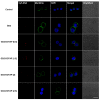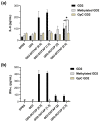Influence of the Charge Ratio of Guanine-Quadruplex Structure-Based CpG Oligodeoxynucleotides and Cationic DOTAP Liposomes on Cytokine Induction Profiles
- PMID: 38002321
- PMCID: PMC10669863
- DOI: 10.3390/biom13111639
Influence of the Charge Ratio of Guanine-Quadruplex Structure-Based CpG Oligodeoxynucleotides and Cationic DOTAP Liposomes on Cytokine Induction Profiles
Abstract
Cationic liposomes, specifically 1,2-dioleoyl-3-trimethylammonium-propane (DOTAP) liposomes, serve as successful carriers for guanine-quadruplex (G4) structure-based cytosine-guanine oligodeoxynucleotides (CpG ODNs). The combined benefits of CpG ODNs forming a G4 structure and a non-viral vector carrier endow the ensuing complex with promising adjuvant properties. Although G4-CpG ODN-DOTAP complexes show a higher immunostimulatory effect than naked G4-CpG ODNs, the effects of the complex composition, especially charge ratios, on the production of the pro-inflammatory cytokines interleukin (IL)-6 and interferon (IFN)-α remain unclear. Here, we examined whether charge ratios drive the bifurcation of cytokine inductions in human peripheral blood mononuclear cells. Linear CpG ODN-DOTAP liposome complexes formed micrometer-sized positively charged agglomerates; G4-CpG ODN-DOTAP liposome complexes with low charge ratios (0.5 and 1.5) formed ~250 nm-sized negatively charged complexes. Notably, low-charge-ratio (0.5 and 1.5) complexes induced significantly higher IL-6 and IFN-α levels simultaneously than high-charge-ratio (2 and 2.5) complexes. Moreover, confocal microscopy indicated a positive correlation between the cellular uptake of the complex and amount of cytokine induced. The observed effects of charge ratios on complex size, surface charge, and affinity for factors that modify cellular-uptake, intracellular-activity, and cytokine-production efficiency highlight the importance of a rational complex design for delivering and controlling G4-CpG ODN activity.
Keywords: CpG oligodeoxynucleotides; cationic liposomes; charge ratio; cytokine induction; guanine quadruplex.
Conflict of interest statement
The authors declare no conflict of interest.
Figures






Similar articles
-
G-quadruplex-based CpG oligodeoxynucleotide/DOTAP complex strongly stimulates immunity in CpG motif-specific and loop-length-dependent manners.Nanomedicine. 2022 Feb;40:102508. doi: 10.1016/j.nano.2021.102508. Epub 2021 Dec 11. Nanomedicine. 2022. PMID: 34906721
-
Non-Modified CpG Oligodeoxynucleotide Forming Guanine-Quadruplex Structure Complexes with ε-Poly-L-Lysine Induce Antibody Production as Vaccine Adjuvants.Biomolecules. 2022 Dec 13;12(12):1868. doi: 10.3390/biom12121868. Biomolecules. 2022. PMID: 36551297 Free PMC article.
-
Attachment of class B CpG ODN onto DOTAP/DC-chol liposome in nasal vaccine formulations augments antigen-specific immune responses in mice.BMC Res Notes. 2017 Jan 26;10(1):68. doi: 10.1186/s13104-017-2380-8. BMC Res Notes. 2017. PMID: 28126014 Free PMC article.
-
CpG ODNs treatments of HIV-1 infected patients may cause the decline of transmission in high risk populations - a review, hypothesis and implications.Virus Genes. 2005 Mar;30(2):251-66. doi: 10.1007/s11262-004-5632-2. Virus Genes. 2005. PMID: 15744581 Review.
-
Structure-dependent immunostimulatory effect of CpG oligodeoxynucleotides and their delivery system.Int J Nanomedicine. 2012;7:2181-95. doi: 10.2147/IJN.S30197. Epub 2012 Apr 27. Int J Nanomedicine. 2012. PMID: 22619554 Free PMC article. Review.
Cited by
-
Immunostimulatory Effects of Guanine-Quadruplex Topologies as Scaffolds for CpG Oligodeoxynucleotides.Biomolecules. 2025 Jan 10;15(1):95. doi: 10.3390/biom15010095. Biomolecules. 2025. PMID: 39858489 Free PMC article.
-
Innovative PEGylated chitosan nanocarriers for co-delivery of doxorubicin and CpG in breast cancer therapy: Preparation, characterization, and immunotherapeutic potential.Med Oncol. 2025 Apr 23;42(5):176. doi: 10.1007/s12032-025-02714-4. Med Oncol. 2025. PMID: 40266471
References
-
- Hornung V., Rothenfusser S., Britsch S., Krug A., Jahrsdörfer B., Giese T., Endres S., Hartmann G. Quantitative Expression of Toll-Like Receptor 1–10 MRNA in Cellular Subsets of Human Peripheral Blood Mononuclear Cells and Sensitivity to CpG Oligodeoxynucleotides. J. Immunol. 2002;168:4531–4537. doi: 10.4049/jimmunol.168.9.4531. - DOI - PubMed
Publication types
MeSH terms
Substances
Grants and funding
LinkOut - more resources
Full Text Sources

